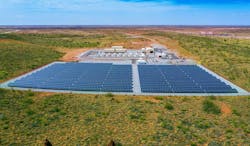Horizon Power announces DERMS rollout for 34 microgrids
Horizon Power plans to launch distributed energy resources management system (DERMS) technology across its microgrids in Western Australia to ease the integration of customer- and utility-owned distributed energy resources.
The regional utility first demonstrated what it calls the microgrid of the future in Onslow, a remote coastal community of about 900 people in Western Australia. Demand for hosting customer solar photovoltaics (PV) had exceeded the limits of what the Onslow microgrid had been designed to handle, and the excess energy combined with the intermittency of the solar PV was creating challenges for the network and its equipment.
Horizon’s solution was to integrate a distributed energy resources management system with its microgrid to manage the community’s growing distributed energy resources. It co-designed the DERMS software with PXiSE Energy Solutions. The software provider discussed its role in the Onslow project in a recent white paper.
In a statement, Horizon Power said that the DERMS technology “enabled more than four times the amount of rooftop solar to be installed than in a traditional energy system.” A demonstration of the technology proved that the system could power Onslow with solar and battery power for 100 minutes.
Lee Ucich, DER technologies manager at Horizon Power, discussed findings from the Onslow project in a Microgrid Knowledge webinar titled “Remote Microgrid Best Practices.”
Horizon Power will now integrate the technology on a much larger scale across Western Australia by rolling out the DERMS to each of its roughly 34 microgrids, which range from 400 kW to 33 MW, in the region.
Horizon’s Ray Achemedei, general manager of technology and digital transformation, said that around 60% of its microgrid systems are at or near capacity for managing rooftop solar. Adding DERMS will mean more Horizon customers will have access to solar, which will lower their energy bills and reduce emissions.
“This deployment is groundbreaking as it enables rooftop solar, customer batteries, electric vehicles, centralized solar and batteries, and the traditional centralized power station to all work together in a coordinated way to maximize renewable energy supply, without adversely impacting power quality and reliability,” Achemedei said.
The DERMS technology rollout will begin in Broome with deployment expected in early 2023. The company plans to deploy the technology in the remainder of its microgrid power systems by mid-2024.
Track news on microgrid projects in Western Australia. Subscribe to the free Microgrid Knowledge Newsletter.
About the Author
Kathy Hitchens
Special Projects Editor
I work as a writer and special projects editor for Microgrid Knowledge. I have over 30 years of writing experience, working with a variety of companies in the renewable energy, electric vehicle and utility sector, as well as those in the entertainment, education, and financial industries. I have a BFA in Media Arts from the University of Arizona and a MBA from the University of Denver.

